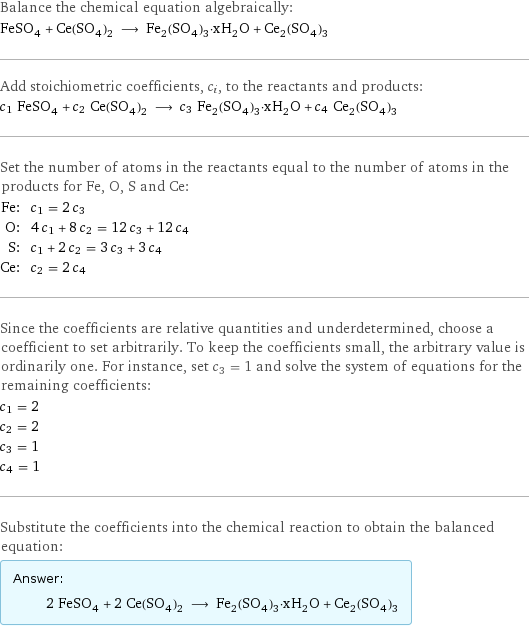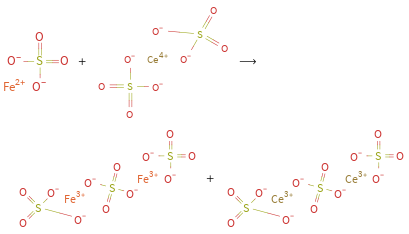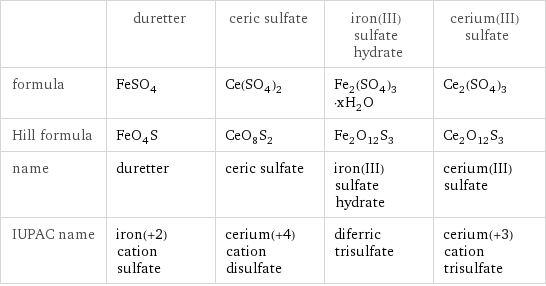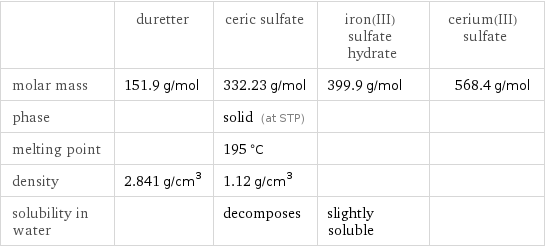Input interpretation

FeSO_4 (duretter) + Ce(SO_4)_2 (ceric sulfate) ⟶ Fe_2(SO_4)_3·xH_2O (iron(III) sulfate hydrate) + Ce_2(SO_4)_3 (cerium(III) sulfate)
Balanced equation

Balance the chemical equation algebraically: FeSO_4 + Ce(SO_4)_2 ⟶ Fe_2(SO_4)_3·xH_2O + Ce_2(SO_4)_3 Add stoichiometric coefficients, c_i, to the reactants and products: c_1 FeSO_4 + c_2 Ce(SO_4)_2 ⟶ c_3 Fe_2(SO_4)_3·xH_2O + c_4 Ce_2(SO_4)_3 Set the number of atoms in the reactants equal to the number of atoms in the products for Fe, O, S and Ce: Fe: | c_1 = 2 c_3 O: | 4 c_1 + 8 c_2 = 12 c_3 + 12 c_4 S: | c_1 + 2 c_2 = 3 c_3 + 3 c_4 Ce: | c_2 = 2 c_4 Since the coefficients are relative quantities and underdetermined, choose a coefficient to set arbitrarily. To keep the coefficients small, the arbitrary value is ordinarily one. For instance, set c_3 = 1 and solve the system of equations for the remaining coefficients: c_1 = 2 c_2 = 2 c_3 = 1 c_4 = 1 Substitute the coefficients into the chemical reaction to obtain the balanced equation: Answer: | | 2 FeSO_4 + 2 Ce(SO_4)_2 ⟶ Fe_2(SO_4)_3·xH_2O + Ce_2(SO_4)_3
Structures

+ ⟶ +
Names

duretter + ceric sulfate ⟶ iron(III) sulfate hydrate + cerium(III) sulfate
Equilibrium constant
![Construct the equilibrium constant, K, expression for: FeSO_4 + Ce(SO_4)_2 ⟶ Fe_2(SO_4)_3·xH_2O + Ce_2(SO_4)_3 Plan: • Balance the chemical equation. • Determine the stoichiometric numbers. • Assemble the activity expression for each chemical species. • Use the activity expressions to build the equilibrium constant expression. Write the balanced chemical equation: 2 FeSO_4 + 2 Ce(SO_4)_2 ⟶ Fe_2(SO_4)_3·xH_2O + Ce_2(SO_4)_3 Assign stoichiometric numbers, ν_i, using the stoichiometric coefficients, c_i, from the balanced chemical equation in the following manner: ν_i = -c_i for reactants and ν_i = c_i for products: chemical species | c_i | ν_i FeSO_4 | 2 | -2 Ce(SO_4)_2 | 2 | -2 Fe_2(SO_4)_3·xH_2O | 1 | 1 Ce_2(SO_4)_3 | 1 | 1 Assemble the activity expressions accounting for the state of matter and ν_i: chemical species | c_i | ν_i | activity expression FeSO_4 | 2 | -2 | ([FeSO4])^(-2) Ce(SO_4)_2 | 2 | -2 | ([Ce(SO4)2])^(-2) Fe_2(SO_4)_3·xH_2O | 1 | 1 | [Fe2(SO4)3·xH2O] Ce_2(SO_4)_3 | 1 | 1 | [Ce2(SO4)3] The equilibrium constant symbol in the concentration basis is: K_c Mulitply the activity expressions to arrive at the K_c expression: Answer: | | K_c = ([FeSO4])^(-2) ([Ce(SO4)2])^(-2) [Fe2(SO4)3·xH2O] [Ce2(SO4)3] = ([Fe2(SO4)3·xH2O] [Ce2(SO4)3])/(([FeSO4])^2 ([Ce(SO4)2])^2)](../image_source/22f474fecb7e1b020d837288953aaa61.png)
Construct the equilibrium constant, K, expression for: FeSO_4 + Ce(SO_4)_2 ⟶ Fe_2(SO_4)_3·xH_2O + Ce_2(SO_4)_3 Plan: • Balance the chemical equation. • Determine the stoichiometric numbers. • Assemble the activity expression for each chemical species. • Use the activity expressions to build the equilibrium constant expression. Write the balanced chemical equation: 2 FeSO_4 + 2 Ce(SO_4)_2 ⟶ Fe_2(SO_4)_3·xH_2O + Ce_2(SO_4)_3 Assign stoichiometric numbers, ν_i, using the stoichiometric coefficients, c_i, from the balanced chemical equation in the following manner: ν_i = -c_i for reactants and ν_i = c_i for products: chemical species | c_i | ν_i FeSO_4 | 2 | -2 Ce(SO_4)_2 | 2 | -2 Fe_2(SO_4)_3·xH_2O | 1 | 1 Ce_2(SO_4)_3 | 1 | 1 Assemble the activity expressions accounting for the state of matter and ν_i: chemical species | c_i | ν_i | activity expression FeSO_4 | 2 | -2 | ([FeSO4])^(-2) Ce(SO_4)_2 | 2 | -2 | ([Ce(SO4)2])^(-2) Fe_2(SO_4)_3·xH_2O | 1 | 1 | [Fe2(SO4)3·xH2O] Ce_2(SO_4)_3 | 1 | 1 | [Ce2(SO4)3] The equilibrium constant symbol in the concentration basis is: K_c Mulitply the activity expressions to arrive at the K_c expression: Answer: | | K_c = ([FeSO4])^(-2) ([Ce(SO4)2])^(-2) [Fe2(SO4)3·xH2O] [Ce2(SO4)3] = ([Fe2(SO4)3·xH2O] [Ce2(SO4)3])/(([FeSO4])^2 ([Ce(SO4)2])^2)
Rate of reaction
![Construct the rate of reaction expression for: FeSO_4 + Ce(SO_4)_2 ⟶ Fe_2(SO_4)_3·xH_2O + Ce_2(SO_4)_3 Plan: • Balance the chemical equation. • Determine the stoichiometric numbers. • Assemble the rate term for each chemical species. • Write the rate of reaction expression. Write the balanced chemical equation: 2 FeSO_4 + 2 Ce(SO_4)_2 ⟶ Fe_2(SO_4)_3·xH_2O + Ce_2(SO_4)_3 Assign stoichiometric numbers, ν_i, using the stoichiometric coefficients, c_i, from the balanced chemical equation in the following manner: ν_i = -c_i for reactants and ν_i = c_i for products: chemical species | c_i | ν_i FeSO_4 | 2 | -2 Ce(SO_4)_2 | 2 | -2 Fe_2(SO_4)_3·xH_2O | 1 | 1 Ce_2(SO_4)_3 | 1 | 1 The rate term for each chemical species, B_i, is 1/ν_i(Δ[B_i])/(Δt) where [B_i] is the amount concentration and t is time: chemical species | c_i | ν_i | rate term FeSO_4 | 2 | -2 | -1/2 (Δ[FeSO4])/(Δt) Ce(SO_4)_2 | 2 | -2 | -1/2 (Δ[Ce(SO4)2])/(Δt) Fe_2(SO_4)_3·xH_2O | 1 | 1 | (Δ[Fe2(SO4)3·xH2O])/(Δt) Ce_2(SO_4)_3 | 1 | 1 | (Δ[Ce2(SO4)3])/(Δt) (for infinitesimal rate of change, replace Δ with d) Set the rate terms equal to each other to arrive at the rate expression: Answer: | | rate = -1/2 (Δ[FeSO4])/(Δt) = -1/2 (Δ[Ce(SO4)2])/(Δt) = (Δ[Fe2(SO4)3·xH2O])/(Δt) = (Δ[Ce2(SO4)3])/(Δt) (assuming constant volume and no accumulation of intermediates or side products)](../image_source/6af0d9249591afbf41232dc56a706fef.png)
Construct the rate of reaction expression for: FeSO_4 + Ce(SO_4)_2 ⟶ Fe_2(SO_4)_3·xH_2O + Ce_2(SO_4)_3 Plan: • Balance the chemical equation. • Determine the stoichiometric numbers. • Assemble the rate term for each chemical species. • Write the rate of reaction expression. Write the balanced chemical equation: 2 FeSO_4 + 2 Ce(SO_4)_2 ⟶ Fe_2(SO_4)_3·xH_2O + Ce_2(SO_4)_3 Assign stoichiometric numbers, ν_i, using the stoichiometric coefficients, c_i, from the balanced chemical equation in the following manner: ν_i = -c_i for reactants and ν_i = c_i for products: chemical species | c_i | ν_i FeSO_4 | 2 | -2 Ce(SO_4)_2 | 2 | -2 Fe_2(SO_4)_3·xH_2O | 1 | 1 Ce_2(SO_4)_3 | 1 | 1 The rate term for each chemical species, B_i, is 1/ν_i(Δ[B_i])/(Δt) where [B_i] is the amount concentration and t is time: chemical species | c_i | ν_i | rate term FeSO_4 | 2 | -2 | -1/2 (Δ[FeSO4])/(Δt) Ce(SO_4)_2 | 2 | -2 | -1/2 (Δ[Ce(SO4)2])/(Δt) Fe_2(SO_4)_3·xH_2O | 1 | 1 | (Δ[Fe2(SO4)3·xH2O])/(Δt) Ce_2(SO_4)_3 | 1 | 1 | (Δ[Ce2(SO4)3])/(Δt) (for infinitesimal rate of change, replace Δ with d) Set the rate terms equal to each other to arrive at the rate expression: Answer: | | rate = -1/2 (Δ[FeSO4])/(Δt) = -1/2 (Δ[Ce(SO4)2])/(Δt) = (Δ[Fe2(SO4)3·xH2O])/(Δt) = (Δ[Ce2(SO4)3])/(Δt) (assuming constant volume and no accumulation of intermediates or side products)
Chemical names and formulas

| duretter | ceric sulfate | iron(III) sulfate hydrate | cerium(III) sulfate formula | FeSO_4 | Ce(SO_4)_2 | Fe_2(SO_4)_3·xH_2O | Ce_2(SO_4)_3 Hill formula | FeO_4S | CeO_8S_2 | Fe_2O_12S_3 | Ce_2O_12S_3 name | duretter | ceric sulfate | iron(III) sulfate hydrate | cerium(III) sulfate IUPAC name | iron(+2) cation sulfate | cerium(+4) cation disulfate | diferric trisulfate | cerium(+3) cation trisulfate
Substance properties

| duretter | ceric sulfate | iron(III) sulfate hydrate | cerium(III) sulfate molar mass | 151.9 g/mol | 332.23 g/mol | 399.9 g/mol | 568.4 g/mol phase | | solid (at STP) | | melting point | | 195 °C | | density | 2.841 g/cm^3 | 1.12 g/cm^3 | | solubility in water | | decomposes | slightly soluble |
Units
